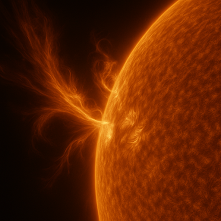Astronomy .1. The Sun : Heart Of The Solar System
The Sun : Heart Of The Solar System
- What is the Sun?
The Sun is a star that is located at the center of the solar system. It comprises mostly of hydrogen and helium. It's energy source is produced by nuclear fusion reactions in its core, where hydrogen atoms are converted into helium.
- What are the different layers of the Sun?
The Sun is made of several layers :
Solar Interior
- The Core- is the most innermost and hottest layer where the conversion of hydrogen atoms to helium takes place.
- The Radiactive Zone - is a layer situated just outside the core, where energy generated in the core is transported outwards by photons of light.
- The Convection Zone- the outermost layer of the solar interior extending from about 200,000 km from the core to the visible surface.
Solar Atmosphere
- The Photosphere- visible surface of the Sun where light is emitted.
- The Chromosphere- A layer just located above the photosphere where temperature increases and it is known for its red light.
- The Transition Region- is a thin and irregular layer of the Sun's atmosphere that separates the hot corona from the less hotter chromosphere.
- The Corona- The outermost layer of the Sun
- Importance of The Sun:-
It is the vital source for life on Earth as it is the main source of energy, life and heat.
- It controls ocean currents and water cycle influencing climate and precipitation patterns.
- It controls weather patterns like formation of wind and cloud cover.
- It supports plant life through photosynthesis.
- The Sun's energy warms the Earth's surface maintaining a temperature suitable for growth of life.
- The Sun's gravitational pull keeps the Earth and other planets in orbit.
- Facts About The Sun:-
- The Sun's light takes about 8 minutes to reach the Earth.
- The Sun constantly emits a stream of charged particles called solar wind that can affect Earth's atmosphere and magnetic field.
- The Sun's energy is produced through nuclear fusion, where hydrogen atoms are converted to helium.
- The Sun is a yellow dwarf star, approximately 4.6 billion years old at the center of the solar system.
- The Sun's gravity holds the entire solar system together, keeping all planets and objects in orbit.
- Solar Activities:-
- Sunspots- They are cooler, darker regions on the Sun's surface where the magnetic field is particularly strong, preventing some heat from reaching the surface.
- Solar Flares- They are sudden and temporary outbursts of electromagnetic radiation along with sunspots and CMEs.
- Coronal Mass Ejections (CMEs)- Large explosions of plasma and magnetic field the sun's outermost layer, Corona that can travel through space and effect the Earth's magnetosphere.
- Solar Wind- A constant stream of charged particles emitted from the Sun's Corona into space.
- Solar Prominence- Large, bright, arched features in the chromosphere and corona extending into the corona.
- Plages- Bright cloud like regions in the chromosphere, often followed along with magnetic activity.








Comments
Post a Comment